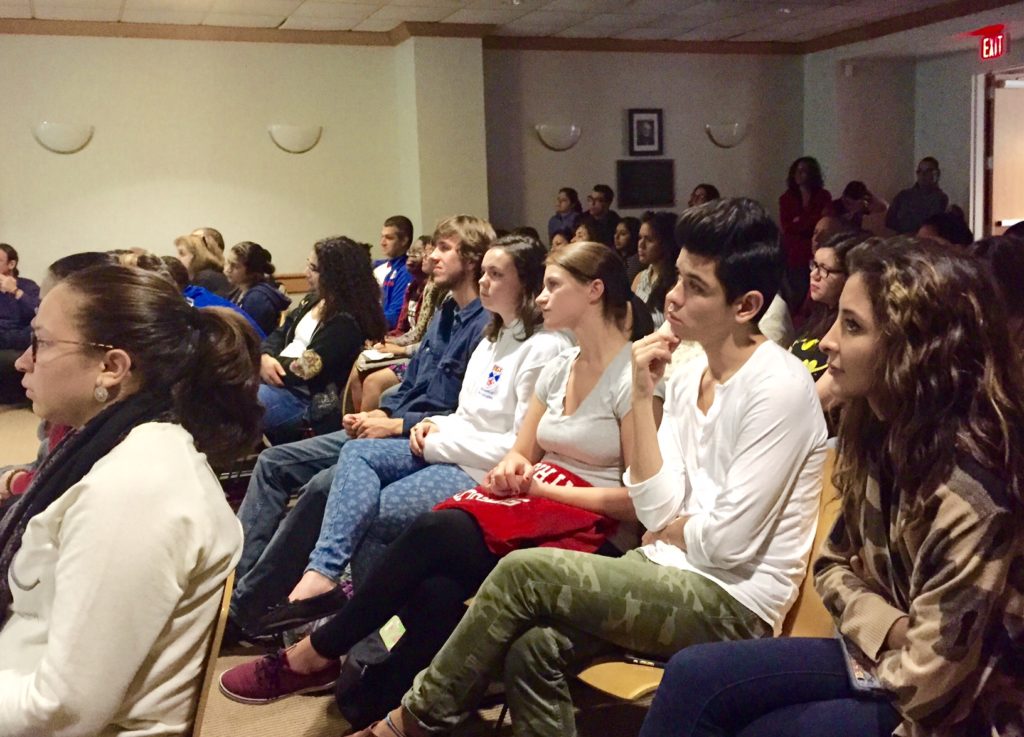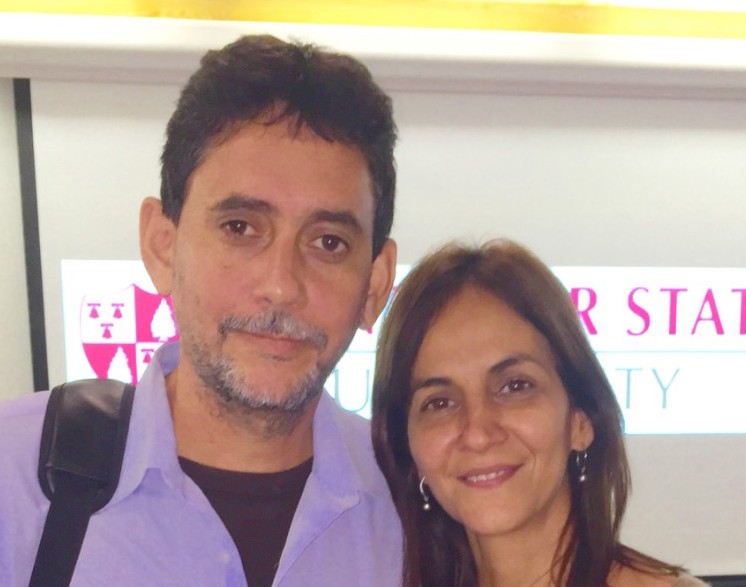Camaguey is the third largest city in central Cuba. Sprinkled with buildings from the 1500s, its short, narrow streets are home to approximately 300,000 inhabitants. Inside this city lives Jorge Luis Santana Perez and Diana Rosa Perez Legon, who have developed an exhibition, development and research circuit of new media.
In an educational exchange event, Santana and Diana Legon have come all the way to Montclair State University to share what they have created. This includes the founding of a cultural center (CEDINM), and the International Video Art Festival of Camaguey (FIVAC), which had its sixth run from March 31 to April 4 this year. In a fascinating trip, Montclair State’s own faculty Beverly Peterson and Roberta Friedman flew to Cuba to attend this festival to share their projects and discover the artistic life of this international event.
The cultural center, CEDINM, is a space unlike anything in Camaguey. There are very few like them and most are within the city of Havana. Its focus is art created with modern technology as opposed to more classical art forms like paint on canvas. Its goal is to increase the development of local and national contemporary media art in Cuba and to foster international communication. The center hosts multiple socio-cultural projects and FIVAC is the largest. Importantly, all of their programs are free. In their own words, CEDINM is aimed at “humanizing technology.”
Peterson and Friedman were in for a treat when they actually arrived at CEDINM. “Within days of arriving in Cuba, we knew we had to share this unique experience with our students. It became wonderful to see how the Montclair State community embraced our guests when Levine and Galoppe created a vital event that helped bring our guests to an even broader university audience.”
In addition to visiting a handful of communication courses at Montclair State, Santana, Legon and translator Raul Gallope, gave an extended presentation for the Film Forum on Tuesday, Oct. 6 and the Department of Spanish and Italian Tuesday, Oct. 14. About 70 students and faculty members gathered in Cohen Lounge to watch pieces assembled by Santana and other collaborative artists as well as footage taken at CEDINM.
Senior Spanish major Daimi Delgado was one of the students deeply affected by their presentation for the Deptartment of Spanish and Italian. Delgado said, “I think the presentation showed the reality of Cuba as it exists right now. I am Cuban and from the very place that their center is located. I definitely feel connected to them. I put myself in their shoes. You definitely see that they want to show the world what they can do.”
Sophomore Spanish major Matthew Kelly said, “I don’t know very much about Cuba, so the presentation helped me put the country in context a little bit. All I know about Cuba is what I know about Che Guevara, who I find interesting.”
“As an educator, it was fantastic to see my students so inspired by Legon and Santana’s visit to our class,” said Peterson. “It is exciting that the Global Education program here at [Montclair State] is playing an important role in this historic opening dialog between two countries.”
When Peterson says “historic,” she may be referring to the germinal expansion of art-centered communication between the United States and Cuba. For almost 60 years now, the United States has enforced a commercial, economic and financial embargo against the country, making communication and travel more difficult for both Cuban and American citizens.
Only in 2009 did President Barack Obama begin to ease constrictions. In January of 2015, policy had become the most lenient it had ever been, allowing open travel to Cuba for Cuban-Americans and selective visas for students and missionaries. Santana and Legon are only two of the several artists allowed “artist visas” that last five years.
After their presentation in Cohen Lounge, Santana, Legon and Gallope sat with the Montclarion to discuss what they’re working on. Santana is an artist and the President of FIVAC. Legon is the producer of FIVAC and CEDINM.

Students in Dickson Hall watched films brought from Cuba and heard about the work of Santana and Legon
Photo Credit: Theadora Lecour
How would you describe the space you have created in Camaguey?
(Legon) It is not a school but a cultural center. We host exhibitions and provide a lab space for collaboration and workshops. We have begun the process of producing resources, but we have not provided much yet. There is very little in terms of equipment that we can deliver. We are mostly an exhibition space. In the future, we would love to make more available to our group.
How accessible are spaces like the one you’ve created?
We are the only one in Camaguey. There are very few outside of Havana that focus on new media.
Is there a relationship that exists between the Camaguey community and CEDINM?
The space is a free access space for everyone. We do not charge admission. In reference to our regular activities, people act within their particular interests towards contemporary art. We also provide a kid’s program every Saturday which is open to the public. It is a space that the community recognizes as open.
Although it is “new media,” do you feel classical art has an influence on the video art you make?
(Santana) I like to go beyond traditional art and incorporate moving images and sounds. There is so much more you can do with the video media. It speaks in a language that involves the spectator much more. Video art has been around for 20 years or so now. In the work I’ve made and in some we have presented, there are references to video art and traditional art. Certainly veterans like Nan U. Pike and Bill Viola, who have pioneered video art, have influenced what I do today.
Why come to Montclair State?
(Legon) We organized this exchange. Two professors from Montclair State visited Cuba to attend the festival [we create]. Beverly Peterson and Roberta Friedman showed their projects at our center and Santana and I have come here to show our projects. We ultimately hope to boost participation and perhaps funds for what we’re doing. People submit to our competition from all over the world and we want to continue this.
Is this your first time in the United States?
(Legon) No. This is our sixth time in the United States and our third time in New York.
Do you notice a difference between being a filmmaker in the United States and a filmmaker in Cuba?
(Santana) [In] the cultural context, definitely. [Also in] the resources and distribution. Aspects of production are different.
(Legon) And of course, economic differences. Our access to tech equipment is limited. Besides that, there is the same artistic freedom.
After two weeks, what is your impression of Montclair State University?
(Santana) It’s very nice.
(Legon) I love it. I would like to send my children here to study. It is a beautiful university. I only hope the students here really understand and appreciate what they have.
What does the future potentially hold for this art exchange?
(Legon) Right now, we are working on an exchange program available to Montclair State students to visit Cuba to learn and share their ideas. There is so much to be learned from each other.




